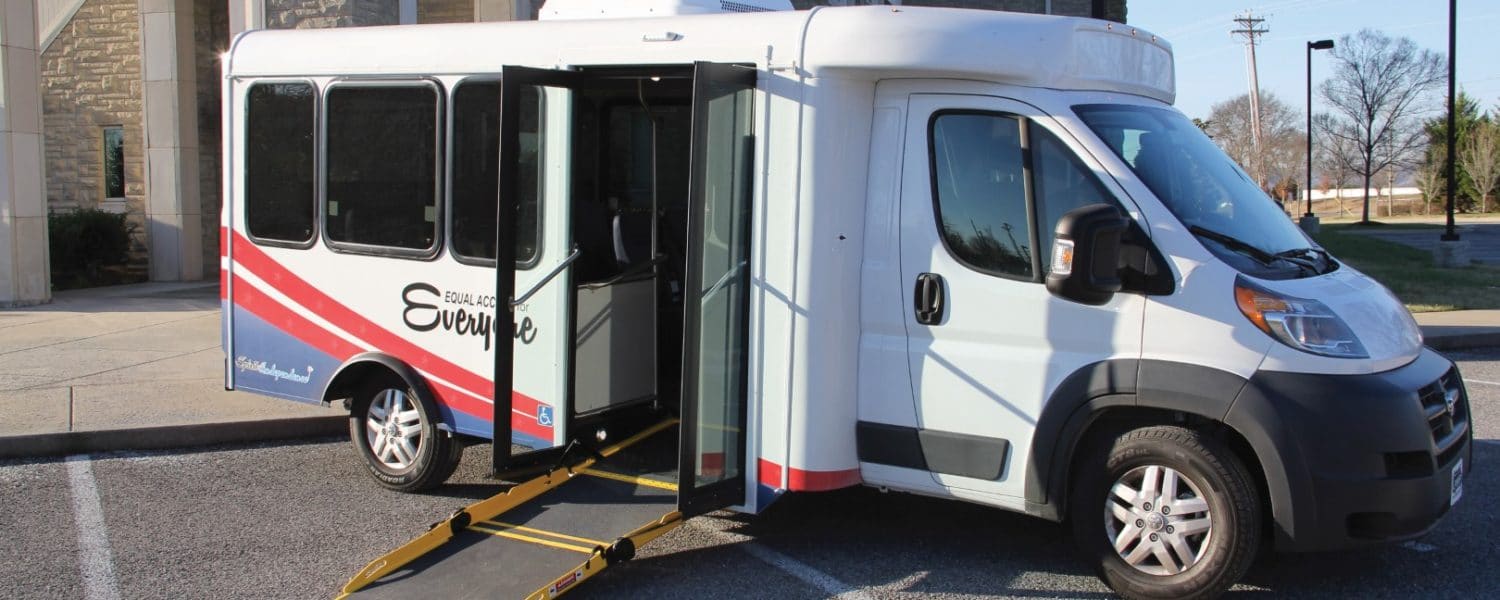Buses that accommodate wheelchair passengers – often called “para-transit buses” – have, up until now, required a mechanical lift to load the wheelchair passengers. These lifts operate like small elevators built into the buses.
Those of you who currently have a para-transit bus in use know the routine. Turn the switch that opens the lift door and lowers the lift, then roll the wheelchair passenger onto the lift, then raise the lift, then roll the wheelchair into position and secure it, and finally, close the lift door.
The other passengers are doing their Christian best to be patient, and the wheelchair passenger is quietly embarrassed that he or she is such an imposition.
And because it’s so much trouble, some have decided they don’t even want to get on the bus. They just stay home.
Well, now there’s another way. It’s called the “low-floor bus.” Instead of using a lift, the wheelchair passenger is wheeled up a ramp.
You have probably seen larger transit buses at airports or those used in municipal transportation that were “low-floor” buses with ramps.
Some of these buses even have the ability to “kneel” to the side of the bus with the door, making it even easier to load wheelchair passengers using a ramp.
But until recently, there haven’t been smaller buses (10 to 25 passengers) – the kind that churches use – that could load passengers using a ramp.
ARBOC Specialty Vehicles in Middlebury, Indiana, is the largest manufacturer of low-floor shuttle buses in the country. In business since 2008, ARBOC has been manufacturing low-floor shuttle buses making it possible for people in wheelchairs to load or unload themselves.
Bryan George, paratransit specialist with Carpenter Bus Sales, says of the new line of low-floor buses they carry, “As we do what we can to make it easier for people requiring wheelchairs to get around, their sense of dignity grows. These low-floor buses help to accomplish that. Everyone enters through the same door.”
The biggest share of those using mobility devices (including wheelchairs and walkers) are found among the elderly, and that number is growing.
According to the most recent US census, “The U.S. population 65 and older is now the largest in terms of size and percent of the population, compared with any previous census.”
But it’s not only the elderly that need mobility devices. The number of handicapped younger people who require wheelchairs or walkers is in the millions.
Comparing Low-Floor Buses with High-Floor Buses
You may be interested to know how a low-floor ramp bus is made compared to a high-floor lift bus. It begins with re-creating the chassis. As you probably know, bus outfitters begin with a chassis from a major vehicle manufacturer.
ARBOC’s Spirit of Independence, for instance, is built on either the Ford Transit chassis or the Dodge Promaster chassis. The Spirit of Freedom is built on the GM G4500 chassis. To bring the finished floor level down, the actual frames of the chassis have to be cut and reconstructed, which is no small task.
This does add to the cost of manufacturing, and that, of course, is reflected in the added cost of purchasing a low-floor bus. But there is no other way to have a ramp slope that meets ADA (Americans with Disabilities Act) specifications.
Regarding price, current prices for a new high-floor 10 + 2WC (10 passengers plus driver plus 2 Wheelchair stations) bus would be around $55,000 to $60,000. A comparable low-floor 10 + 2 WC would cost around $90,000. So, if you rarely transport wheelchair passengers, the extra cost will not make sense.
But if you are regularly transporting them, the cost is reasonable for the benefit, especially if you divide the cost differential by number of years you will likely own the bus. (Churches usually operate a bus for 8 to 10 years before they replace it.)
One of the biggest advantages of the low-floor shuttle buses is the time it takes to load people on wheelchairs. Tests have shown that loading people with wheelchairs onto low-floor buses is easily twice as fast.
There’s an online video that shows a side-by-side comparison between loading 3 passengers on a low-floor and on a high-floor bus. In this test, it took 3 times longer (9 minutes :: 3 minutes) to board the passengers with mobility aids onto the high-floor bus than onto a low-floor bus.
Also of interest in this comparison is the increased temperature inside the high-floor bus because a larger door was opened for a longer time than the low-floor bus. The outside temperature was 91º. The temperature inside the low-floor bus rose only 4º compared to 13º (to 85º) in the high-floor bus. Imagine the effects of the larger door opened longer on an icy cold day!
What’s Available?
These low-floor buses come in various configurations. The 10 + 2WC (10 passengers plus 2 wheelchair stations plus driver) (shown in picture) is one of the most popular. It is built on a 22’ chassis.
Other configurations include the 12 + 2WC, which is built on a 23’ chassis, and the 16 + 2WC, which is built on a 26’ chassis and has storage space in the back.
Keep in mind that any total capacity of more than 15 requires that the driver have a Commercial Driver’s License.
ARBOC’s Spirit of Mobility model has a special air-ride suspension and a kneeling feature, allowing the bus to load from a curb without deploying the ramp. That makes for even faster loading and unloading.
All of these low-floor buses are Altoona tested and meet all Federal Motor Vehicle Safety Standards (FMVSS).
Low-Floor Vans
Everything we’ve said so far is about low-floor buses. However, if you just need to transport 1 or 2 wheelchair passengers, you may want to consider a ramp-accessible van. These come in various configurations: 4 + 1WC, or 2 + 2WC, for instance.
Some churches have decided to have a dedicated, handicapped-accessible van as part of their fleet. Their other bus (or buses) would then not be wheelchair-equipped.
These vans are all built on the smaller mini-van chassis, like the Dodge Caravan chassis or the Chrysler Pacifica chass. Some have side-entry ramps; others have rear-entry ramps. There are several manufacturers out there to choose from. Their products are continually being updated with new innovations.
The good news is that there are now new ways to look after those we love who use mobility aids!
For more information on either the low-floor buses or vans, Carpenter Bus’ Paratransit Specialist Bryan George, would be glad to talk with you (615-376-2287, bgeorge@carpenterbus.com).












